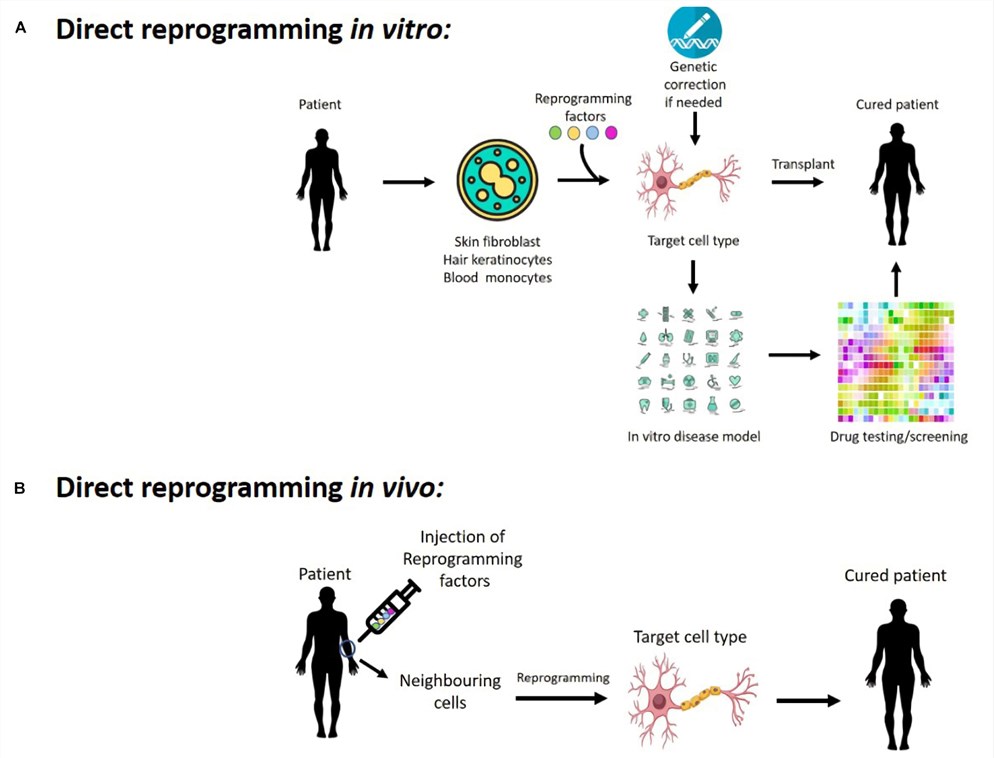Lentiviral Vector Design for Cellular Reprogramming
Cellular reprogramming has attracted much attention in the past decade due to its enormous potential in generating functional cells for cell therapies. Creative Biolabs has advanced platforms and cutting-edge technologies in the field of lentiviral vectors (LVs) design for cellular reprogramming. Our rapid and robust custom services of cellular reprogramming can streamline your research with an array of methods to meet your needs.
Introduction of Cellular Reprogramming
Cellular reprogramming is the conversion of one cell type to another via the activation of gene networks that control a particular cell phenotype. This reprogramming technology represents a rapid way to generate target cells in both basic and clinical settings, which can be used for transplantation and studies of biology and diseases. Cellular reprogramming is typically achieved by overexpression of natural reprogramming factors (RFs) that control the gene networks corresponding to the desired cell phenotypes. The most prominent example of cellular reprogramming is the generation of induced pluripotent stem cells (iPSCs) from murine and human skin fibroblasts with four transcription factors (Oct4, Klf4, Sox2, c-Myc), which opened up the possibility of deriving different tissues by iPSC re-differentiation. This strategy has also been used to induce somatic pluripotency and to directly convert one somatic cell type into another, such as the conversion of fibroblasts to myoblasts, cardiomyocytes, neurons, or hepatocytes. These new cell types can then be used for patient-specific disease modeling, drug screening, and regenerative medicine.
 Figure 1. Potentials of cellular reprogramming (A) in vitro and (B) in vivo for regenerative medicine, disease modeling, drug screening/testing as well as cell therapy. (Fang, 2018)
Figure 1. Potentials of cellular reprogramming (A) in vitro and (B) in vivo for regenerative medicine, disease modeling, drug screening/testing as well as cell therapy. (Fang, 2018)
LVs for Cellular Reprogramming
The generation of iPSCs typically requires multiple individual viral vectors to deliver these transcription factors (Oct4, Sox2, KIf4, and cMyc) needed to induce reprogramming, and the sustained expression of four transcription factors for a limited period of time (10-30 days). LVs infect dividing and nondividing cells, have a larger cloning capacity (8-10 kb) than other retroviral vectors and lasting transgene expression, which makes it possible to use a polycistronic cassette that expresses multiple RFs driven by one promoter. Integrating LVs can efficiently and reliably generate iPSCs, but they have some security issues. It is not well controlled following reprogramming, and transgene expression and retention are detrimental or pose potential risks after reprogramming, such as incomplete silencing of the transgene, random integration leading to the risk of insertional mutagenesis, and residual expression and reactivation of the transgenes. This can be overcome by using Cre-deletable or Tet-inducible LVs. Tet-inducible LV delivery vector can control the timing and magnitude of expression of the RFs. Cre-lox LVs is the same as using a standard lentiviral vector, but transient expression of Cre recombinase allows for the deletion of the inserted transgenes that are flanked by loxP sites.
Services
Unlike traditional iPSCs generation which requires simultaneous co-infection by four separate expression vectors, Creative Biolabs has developed various polycistronic LVs for expression of all four stem cell transcription factors self-cleaving 2A peptides. The transcription factor open reading frame (ORF) is followed by a reporter gene to verify viral transduction into your target cell. Our polycistronic LVs have four transcription factors instead of co-transducing four separate expression vectors, and reprogramming sequences can be efficiently deleted from the iPSCs cell genome, which significantly improves reprogramming efficiency and reduces the number of viral integrations. The LVs for cellular reprogramming we design are at least 10-fold higher efficiency than the traditional methods, in part because it is easier to infect cells with a single virus than with a pool of multiple viruses. In addition to LVs design for cellular reprogramming, Creative Biolabs also offers other customized services, such as codon optimization of the RFs (to more favored human tRNA usage) and analysis of reprogramming efficiency, to meet customers' needs and better serve your project.
Service Highlight
- A simple, hands-free workflow for reliable reprogramming
- Safe for all stages of your research from basic research to pre-clinical research
- Flexible in source cell selection
- The best price and the best quality in its class
- Fast turnaround time
- Expert technical support, full confidentiality, and on-time delivery
Creative Biolabs is a leading commercial supplier of viral vector technologies, offering the most comprehensive services of LVs design for cellular reprogramming for customers worldwide. With our unique LVs design platform technology, we will continue to consider your requests to bring you more flexibility. Please feel free to contact us for more information.
Reference
- Fang, L.; et al. (2018). Potentials of Cellular Reprogramming as a Novel Strategy for Neuroregeneration. Front Cell Neurosci. 12:460. Distributed under Open Access license CC BY 4.0, without modification.
